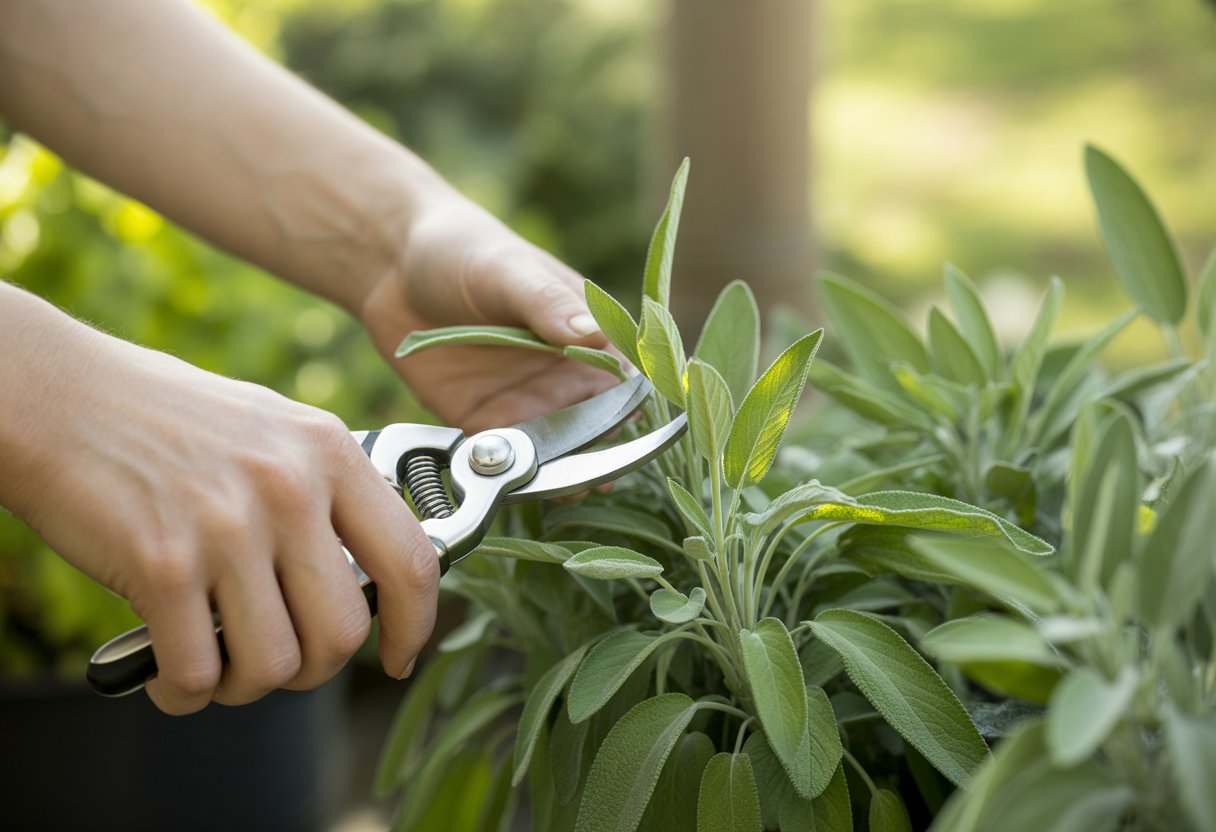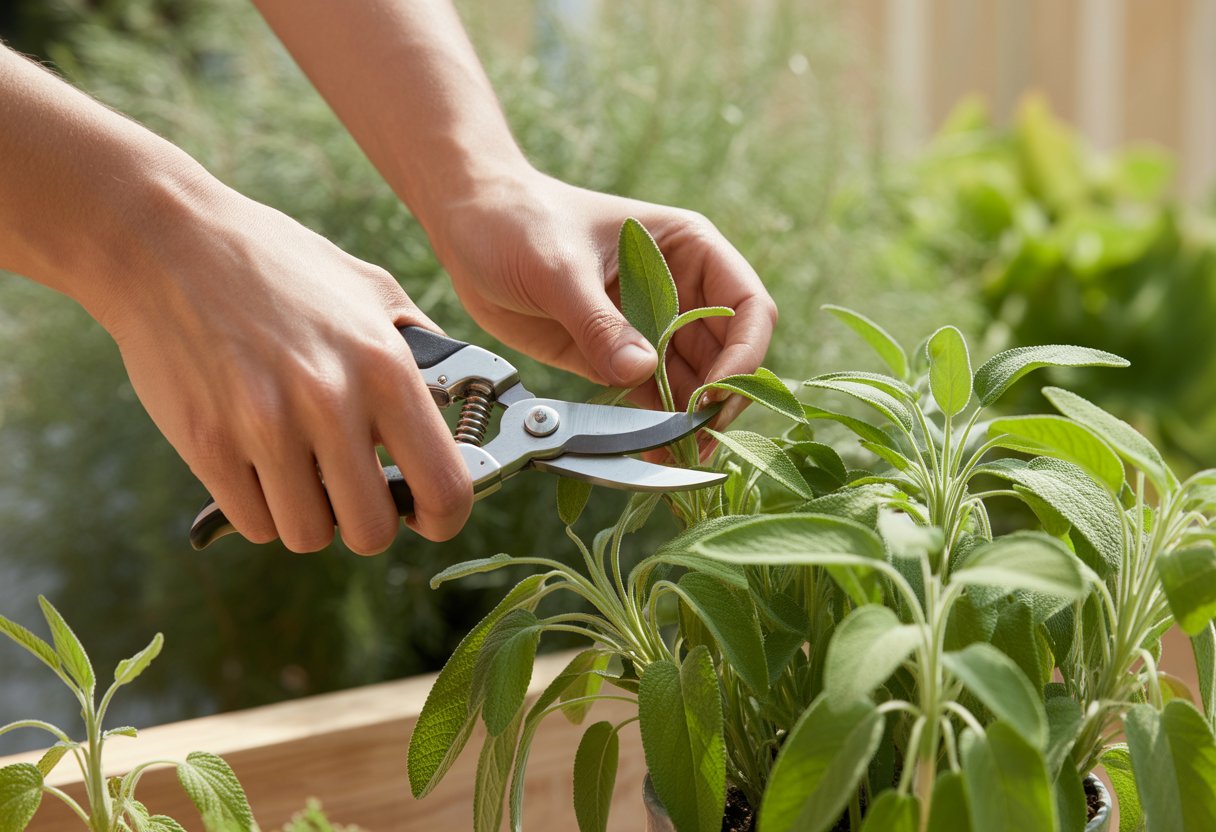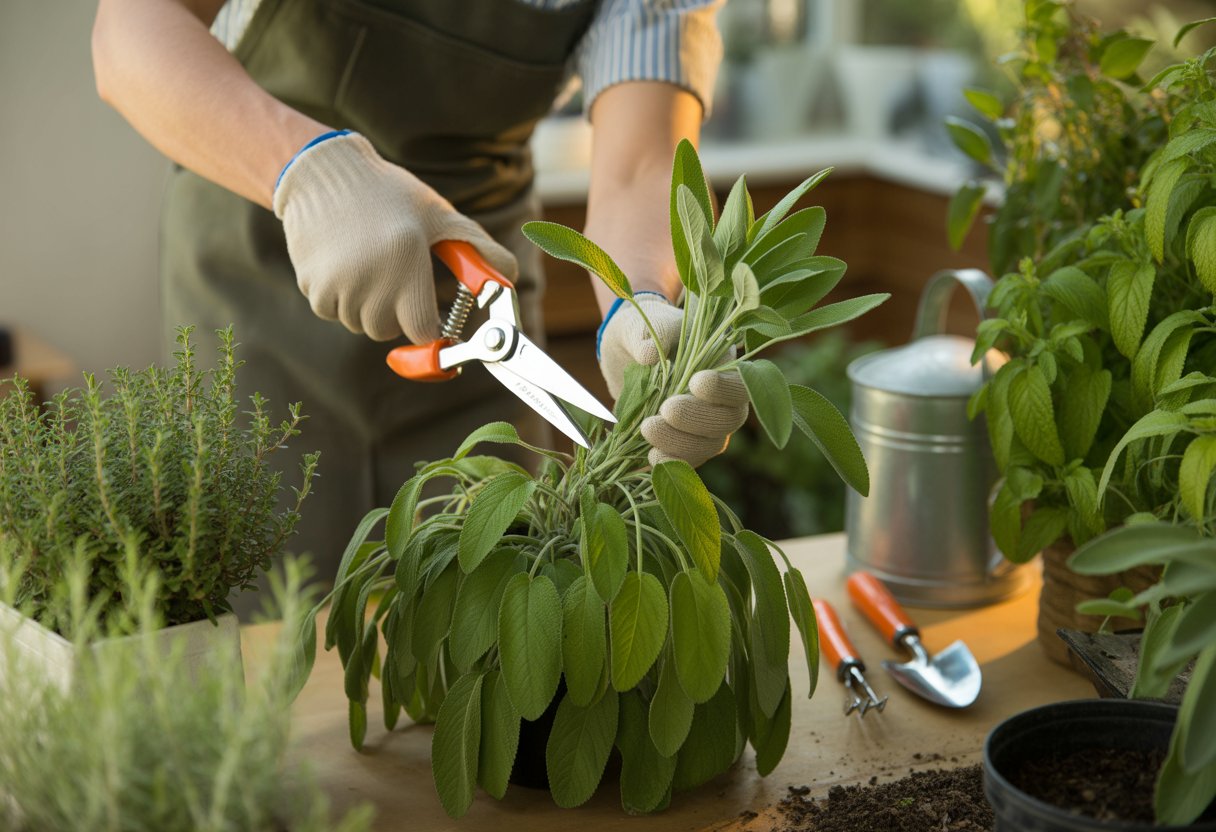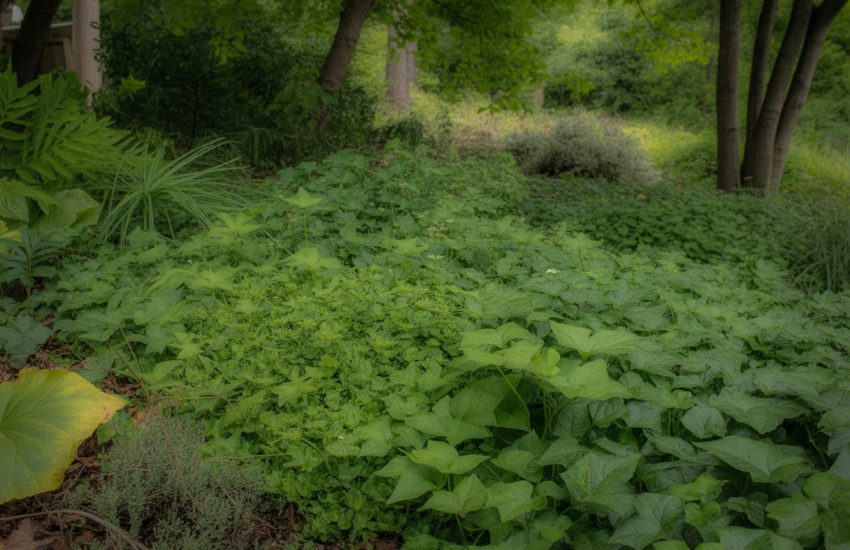How to Prune Sage for Optimal Growth and Health
Pruning sage, that classic perennial from the Lamiaceae family, really helps keep it healthy and fragrant. If you want to prune it right, just cut back about a third of the plant’s soft, leafy stems after it flowers or in early spring. Steer clear of the woody bits.
This pushes out new sage leaves and keeps things vigorous.

Sage—Salvia officinalis—responds well to regular trims. If you skip pruning, it gets leggy and a bit wild.
Taking out older stems makes room for fresh growth, and the leaves taste way better. That’s perfect for cooking or mixing up herbal teas.
Pruning also helps shape sage into a neat, manageable plant. It’s a simple way to keep it productive year after year.
Why and When to Prune Sage
When you prune sage, you encourage new, vigorous stems and get better air flow around the plant. If you know when to trim and spot the signs that sage needs a haircut, you’ll end up with bushier, more productive plants.
Benefits of Pruning
Pruning breathes new life into sage by taking out those old, woody stems. You get denser, bushier growth instead of awkward, spindly branches.
Better air circulation keeps fungal problems at bay. Plus, regular trims mean more leaves and a bigger punch of flavor—fresh growth is always more aromatic.
When you cut off spent flowers, you keep the plant focused on making leaves. More leaves, better quality—what’s not to like?
Identifying the Right Time
Aim to prune sage in early spring, right as you see new growth but before it fully wakes up from dormancy. This helps the plant bounce back strong.
You can do light trims through the growing season to keep things tidy. Just avoid heavy cuts in late autumn or winter, since that can stress the plant.
If you miss the spring window, a light trim in late spring still helps. Young sage plants, especially in their first year, need a gentle touch—don’t go overboard.
Recognizing Plants Ready for Pruning
You’ll know sage needs pruning when you spot woody, dry stems and patchy leaf growth. If it’s looking overgrown or floppy, it’s time for a trim.
Look for faded stems and leaves that have lost their aroma. Those are signs the plant needs a bit of a refresh.
First-year sage only needs a little pruning. Older, heavily-flowered plants benefit from a more thorough cutback to stay healthy.
Tools and Preparation
Having the right tools and keeping them clean really matters. Pick a good spot for pruning—these little things make a big difference for plant health.
Essential Pruning Tools
Go for sharp garden shears or pruning shears for clean cuts. If you’re dealing with thick stems, secateurs do the trick.
Scissors can handle small shoots, but don’t use them for main branches. Comfortable, sturdy tools make a world of difference, especially for precise cuts.
A small container for clippings helps keep your workspace tidy. It also keeps pests from moving in.
How to Clean and Sanitize Equipment
Disinfect your tools before and after pruning. A quick wipe with rubbing alcohol or diluted bleach works well.
Rinse and dry everything to prevent rust. Clean tools last longer and cut better.
Don’t share tools between different plants unless you’ve cleaned them. That’s just asking for trouble with cross-contamination.
Choosing the Right Location
Prune sage outdoors if you can, in a spot with full sun and well-drained soil. This sets the stage for healthy regrowth.
If you’re stuck indoors, a sunny kitchen window works. Water the plant after pruning to help it recover.
Make sure there’s plenty of air moving around to keep mold and fungus away.
How to Prune Sage Step-by-Step

Pruning sage is a mix of observation, technique, and a bit of routine care. It’s about removing what’s dead or damaged and shaping things up so new growth can thrive.
Assessing Plant Health and Growth
Start by checking the plant. Find any damaged branches, yellow leaves, or dead wood. Take those out first—they just drag the plant down.
Look for new shoots popping up. Healthy sage has firm, green leaves and stems. If you see discoloration or soft spots, snip those branches to keep the plant in good shape.
Pruning Techniques and Best Practices
Use clean, sharp shears—don’t skimp here. Cut branches at a 45-degree angle, about a quarter inch above a leaf node or side branch.
Don’t cut more than a third of the plant at once. Focus on shaping the plant by trimming long or unruly branches.
Skip cutting into old, woody stems. Sage doesn’t bounce back well from those.
Removing Flower Stalks and Deadheading
Flowers look nice, but they pull energy away from leaf growth. Once blooms fade, use your shears to cut flower stalks near the base.
Deadhead—or remove spent flowers—to keep the plant looking good and producing leaves. Check for flower stalks regularly and prune to push out more leafy branches.
Aftercare and Encouraging Healthy Growth
Once you’re done pruning, give the sage a good drink. If you want, add a balanced fertilizer to help it recover.
A little compost around the base helps the soil hold moisture and nutrients. Light touch-up pruning every few weeks keeps things healthy.
Try not to prune heavily late in the season—winter damage is no joke.
Troubleshooting, Maintenance, and Harvest

Keeping sage productive and fragrant takes a bit of attention. Managing pests, watching for disease, and timing your harvest all play a part.
Common Problems and Pest Control
Sage sometimes gets hit with grey mould (Botrytis cinerea), especially if things are damp or crowded. Remove any affected leaves and boost air flow to keep it in check.
Aphids and spider mites are common pests. Aphids gather on new shoots and make leaves curl. Spider mites spin fine webs and turn leaves yellow.
Check your plants often. If you spot pests, try insecticidal soap or neem oil.
Overwatering can cause root rot. Sage likes its soil on the dry side. If the plant wilts and the soil is soggy, you might need to trim damaged roots and cut back on watering.
If you skip pruning, sage gets woody and wild. Regular trims keep it fresh and healthy.
Long-Term Care and Seasonal Tips
Prune sage in late spring or early summer to keep it in shape and boost leaf growth. Avoid heavy pruning in autumn—winter frost can really damage exposed wood.
In winter, mulch around the plant or bring potted sage inside. If you live somewhere cold, cut back tall, woody stems before frost hits.
In warmer spots, you can mostly leave sage alone during dormancy. Keep up with dead branch removal and divide mature plants every few years to keep them productive.
Sage loves sunlight and moderate watering through the growing season. That’s the sweet spot for health.
Harvesting and Culinary Use
Pick sage leaves just before the plant flowers—that’s when the oils and aroma peak. Early morning is best if you want to capture flavor.
Use sharp scissors and cut just above a leaf node. That encourages new growth.
Use fresh leaves in your cooking or dry them for later. Dry them in a dark, airy spot to keep the flavor strong.
Dried sage keeps its punch for up to a year. Cooking with sage adds depth to meats, sauces, and stuffings.
Regular harvesting keeps the leaves coming and stops the plant from getting woody. That’s a win-win for you and your sage.
Propagating Sage from Cuttings
Take softwood cuttings in late spring or early summer. Shoots about 3-4 inches long work best—just snip them right below a node.
Pluck off the lower leaves. Dip that cut end in rooting hormone if you have it.
Stick the cutting into moist, well-drained soil or a propagation mix. Cover it loosely with plastic to keep humidity up, but don’t let it sit in direct sun.
Roots tend to show up in three or four weeks. Once you see growth, start acclimating the new plant to outdoor life before moving it to the garden.


